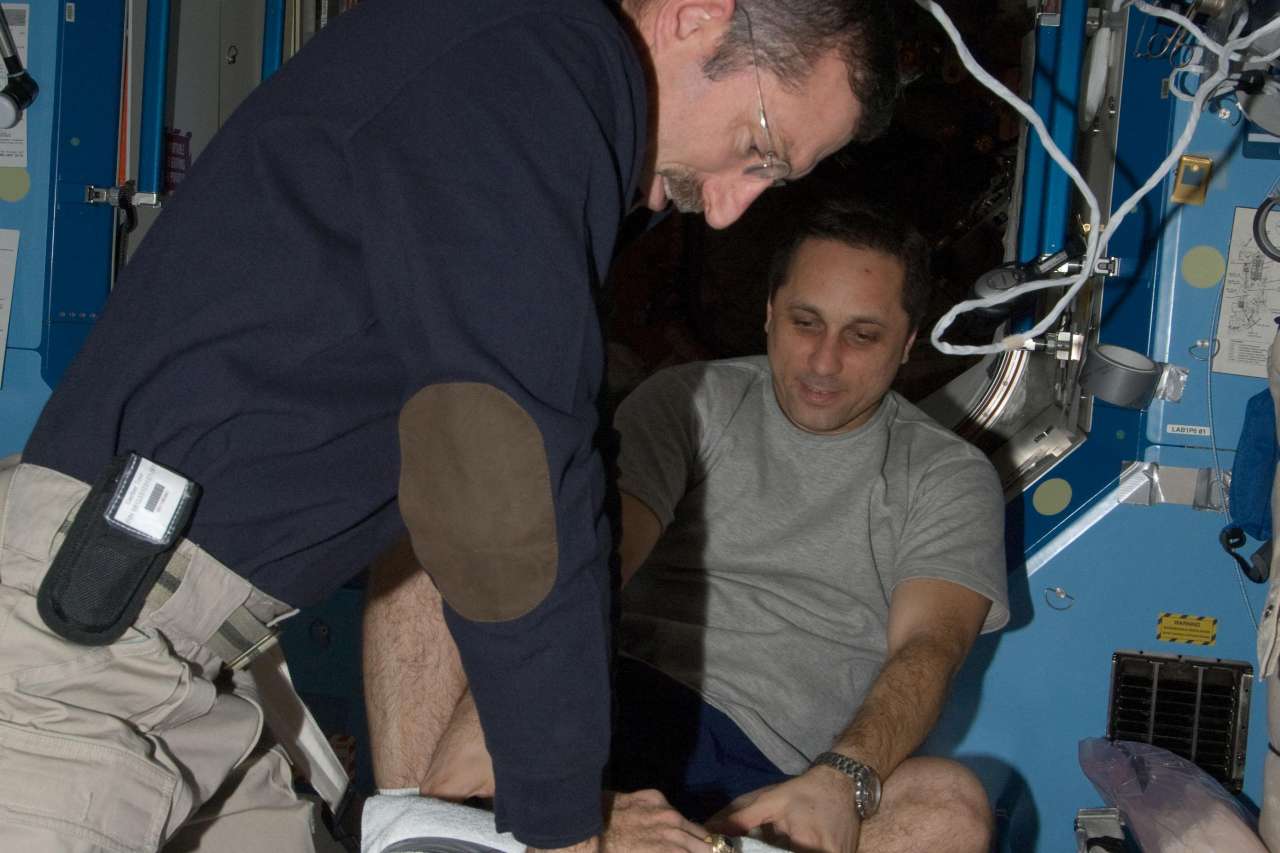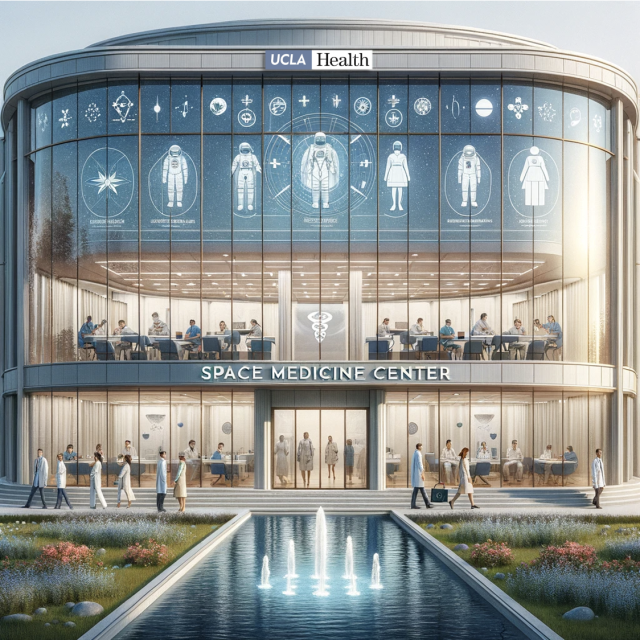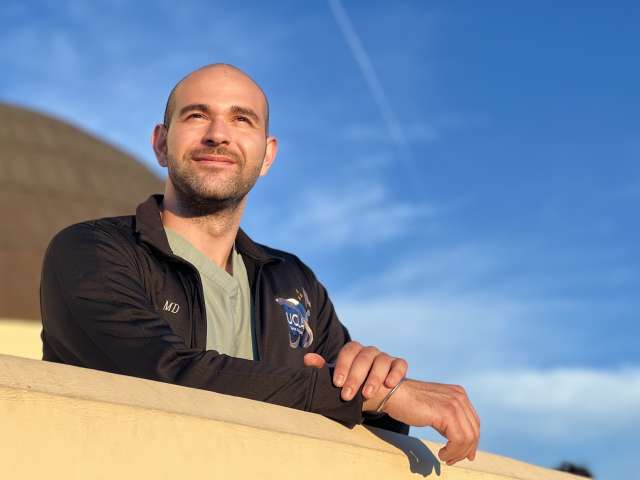Space Medicine
The UCLA Space Medicine Center

The UCLA Space Medicine Center is a hub of innovation, where medicine meets space exploration to create new possibilities for human health and safety beyond Earth. As pioneers in the medical field, we are dedicated to tackling the unique challenges of healthcare in space by developing new medical technologies, treatment methodologies, and training pathways to ensure the health and safety of astronauts as we pursue making our species multiplanetary.
As a cornerstone in aerospace advancements, UCLA is the leading academic institution for space medicine on the west coast. Collaborations with on space health research, participation in missions, one of just a handful of academic affiliates of the , development of biomedical devices for space, and educational initiatives with and VAST highlight UCLA’s commitment to advancing both aerospace technology and space medicine. Our proactive approach to solving health challenges underscores UCLA's integral role in shaping the future of space medicine. At the UCLA Space Medicine Center, we empower astronauts to reach for the stars with our unparalleled training and treatments, ensuring a safe and successful journey into the future.
What is Space Medicine?

Space Medicine is a specialized field of medicine that focuses on maintaining the health, safety, and performance of crewmembers in the harsh environment of space and distant planetary bodies. Microgravity, radiation exposure, and the psychological stressors of confinement and isolation are some of the hardships astronauts face while traveling through space, where traditional medical procedures and treatments may not be feasible. Through developing new and innovative techniques and treating illnesses in space, our program aims to enhance the survivability and success of astronauts in order to make long-term space habitation possible–both now, and for future generations of space explorers.
What The Space Medicine Center Does Today
Our Space Medicine Center at UCLA continues to lead in cutting-edge research and clinical practice, applying evidence-based medicine to advance human health in space. While we cannot disclose all operational details due to ongoing contractual agreements, our team actively performs medical screening of astronauts, trains crew members in critical medical procedures, supplies novel medications for spaceflight, and conducts specialized research for the private spaceflight industry. We also employ multiple flight surgeons who work across the private space industry, manage in-flight medical care, and oversee pre- and post-mission programs including launch and recovery operations. Additionally, as one of only a few academic affiliates of the United States Space Command, we play a pivotal role in national efforts to ensure safe and effective space operations. In line with our academic mission, our Center delivers comprehensive medical education, preparing the next generation of aerospace clinicians and fostering innovation that benefits both spacefarers and patients on Earth.
Training for the New Frontier
, established in 2021, is the first emergency medicine space medicine fellowship program. It is designed to equip physicians with the skills needed to provide healthcare in space environments. The program offers a robust curriculum that includes clinical rotations, aerospace engineering education, and hands-on experiences with space agencies.
The fellowship includes rotations at and , specialized engineering coursework developed with and , and biomechanical engineering training at . Fellows also have the ability to undergo austere medical training in antarctica and participate in Mars analog missions to simulate the conditions and health risks on Martian surfaces. We are also developing Allied Health training programs for paramedics and nurses, aiming to expand our training capabilities to support the growing demands of space missions.
Our Team
Our team features key members from all aspects of the public and private aerospace industry. Dr. Haig Aintablian, MD, the director of the UCLA Space Medicine Program, leads this initiative and has an extensive background in emergency medicine and space medicine, having co-founded the nation’s first emergency medicine-based space medicine training pathway with Jo Feldman, MD and Gregory Hendey, MD. Between them, Haig and Jo have supported countless astronaut missions for the public and private industries and have been integral in the advancement of UCLA’s space medicine initiative.
The Future of the UCLA Space Medicine Center
Our vision is to establish a comprehensive healthcare framework for space missions, ensuring both the immediate health needs of astronauts and the long-term sustainability of human life in space. From developing a Virtual Space Medicine Center to a Lunar and Martian Mohave Desert Analog Site, UCLA Space Medicine Center will combine cutting-edge technology, rigorous training protocols, and ever-expanding innovations to define the new era of space medicine.

Our vision is to establish a comprehensive healthcare framework for space missions, ensuring both the immediate health needs of astronauts and the long-term sustainability of human life in space. Below are the key goals and projects that outline our phased approach to achieving this vision:
Current Phase (0-2 years):
- UCLA Space Medicine Fellowship: Our fellowship offers unique training with SpaceX, Caltech/JPL, VAST, and exposure to austere environments. It includes comprehensive procedural training and formal certification to become a flight surgeon. We aim to expand the fellowship and make it the definitive standard for space medicine training.
- Comprehensive Astronaut Health Screening Program: We are expanding our current pre-flight astronaut medical screening program to provide a complete pre- to post-flight all-inclusive medical screening and tracking program, using multiple diagnostic modalities and expert consultations. This program aims to overcome specific health challenges and enable any company, big or small, to be able to screen astronauts effectively and efficiently.
- Virtual Space Medicine Center (USPACE): We plan to establish a virtual center to foster collaboration among UCLA departments and external partners. This center will support scholarly activities, provide research grant support, and mentorship opportunities for medical students, residents, and physicians interested in space medicine.
- UCLA Space Multi-Departmental Research Collaborative: We will launch a collaborative effort involving stakeholders from major medical departments at UCLA Health. This includes funding for research on topics such as Space Motion Sickness and Spaceflight Associated Neuro-ocular Syndrome.
Intermediate Phase (3-5 years):
- Training Program Expansion: With additional funding, we plan to expand training opportunities for other health professions including paramedics and nurses. This will be tailored to include aspects of space physiology and pathology that will help bring all healthcare professions to the forefront of space. We also aim to offer more advanced simulations and analogs associated with this expansion.
- Advanced First Aid for Astronauts Course: We are developing the first formalized medical training course for astronauts, focusing on first aid in Martian and Lunar surface analogs. This course will train astronauts in handling potential problems such as suit breaches, hypobaric injury, and thermal burns.
Definitive Phase (5-7 years):
- UCLA Space Medicine Center: We envision building a state-of-the-art Space Medicine Center that includes:
- Neutral Buoyancy Pool for Weightlessness Training: Essential for training astronauts in weightlessness, allowing them to practice tasks they might perform outside a spacecraft.
- Human Rated Vacuum Chamber: Vital for testing space suits and other extra-vehicular accessories accurately.
- Hyperbaric/Hypobaric Chamber: Crucial for studying the effects of varying pressure levels on the human body and training astronauts for decompression sickness and other pressure-related injuries.
- Expansion of Researchers and Staff: Establishing a thriving ecosystem of professionals dedicated to advancing space medicine through continuous research and innovation.
- Lunar and Martian Mohave Desert Analog Site: A planetary surface analog site, such as the Mojave Desert, where conditions can simulate those on Mars and the Moon, will be built to train astronauts and healthcare professionals in many of the above programs. This desert site will serve as an invaluable training ground, providing realistic environments to prepare astronauts for extraterrestrial missions and provide insight to healthcare professionals about the specific logistical hazards astronauts will face on missions.

By achieving these milestones, we aim to ensure the safety, productivity, and success of humanity’s ventures into space. This vision leverages UCLA's strategic location, existing programs, and relationships with aerospace giants like SpaceX and NASA, positioning us at the forefront of space medicine advancements.

Join Us on This Adventure
We invite you to support our mission through financial contributions. Your support will help us expand our research capabilities, enhance our training programs, and develop new technologies and initiatives that will shape the future of space medicine. Explore how you can contribute to our groundbreaking work through philanthropy. Together, we can pioneer the future of human spaceflight and ensure the health and safety of humanity as we venture beyond Earth.